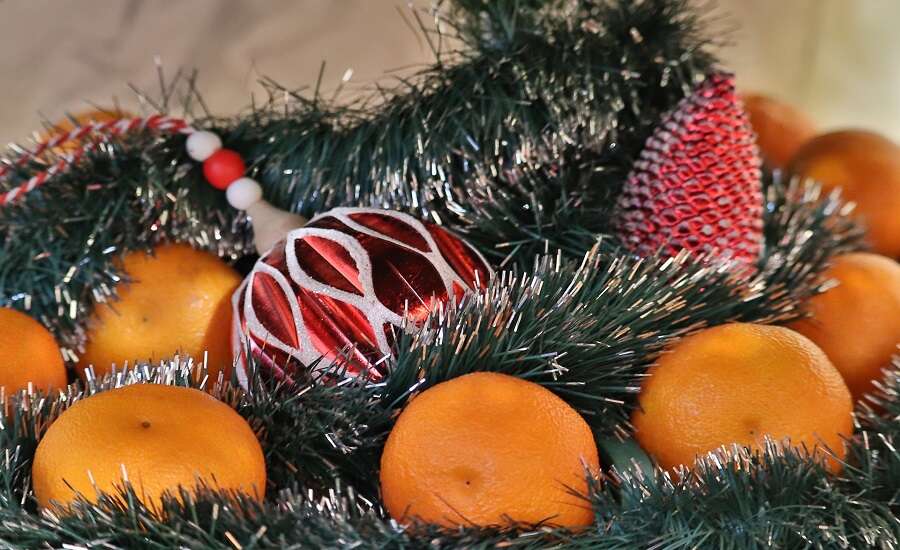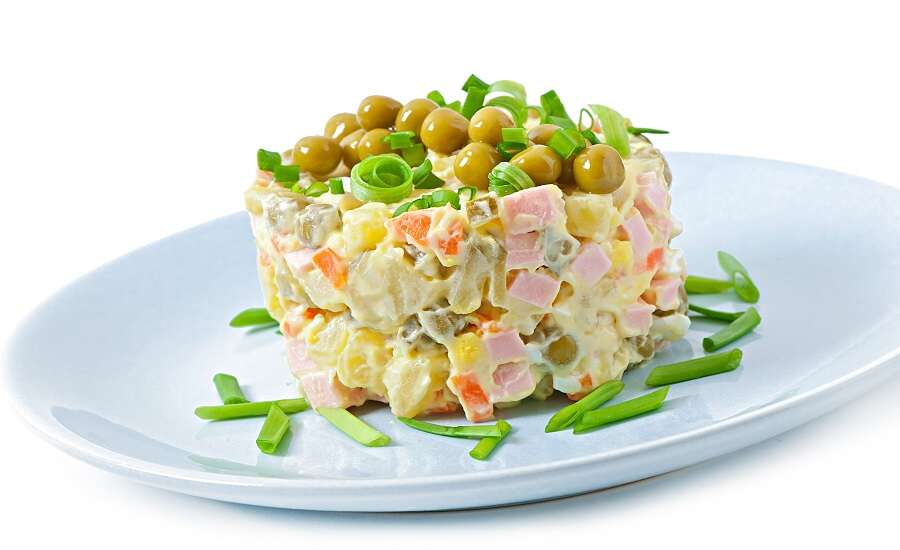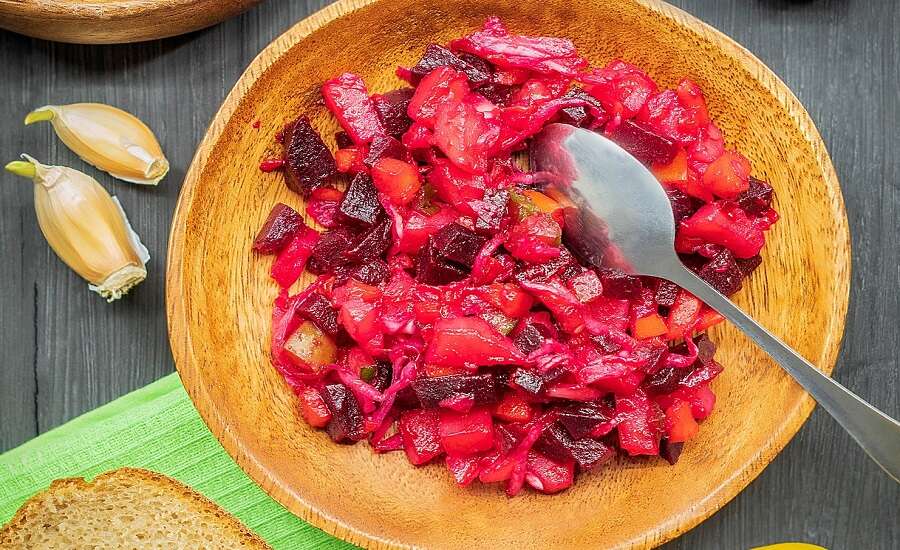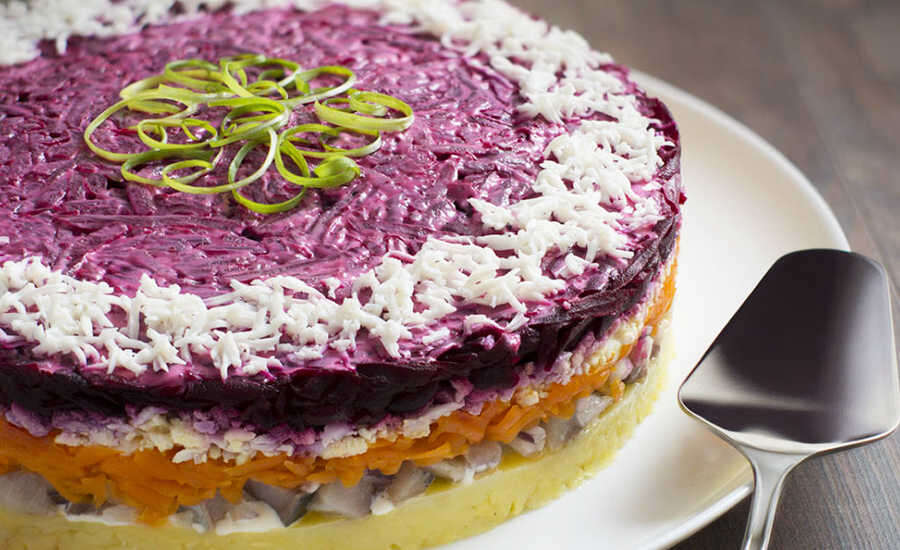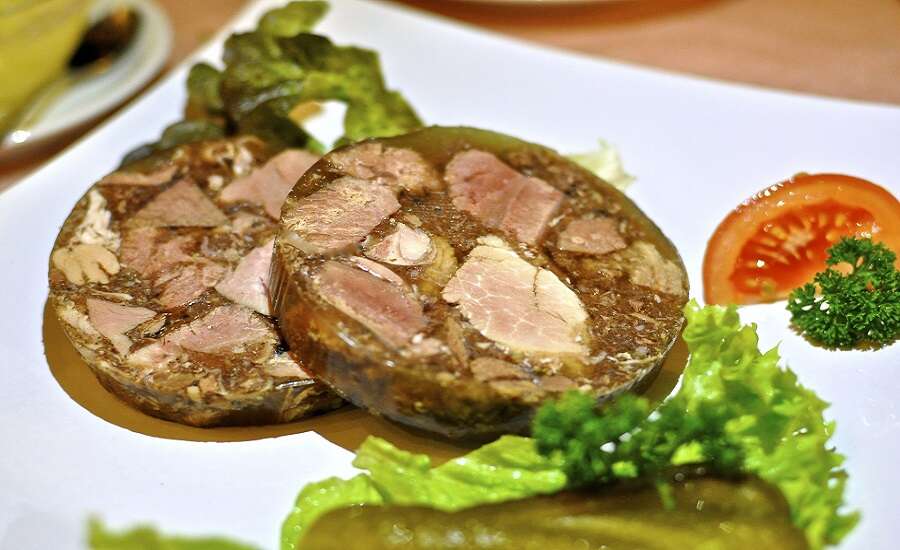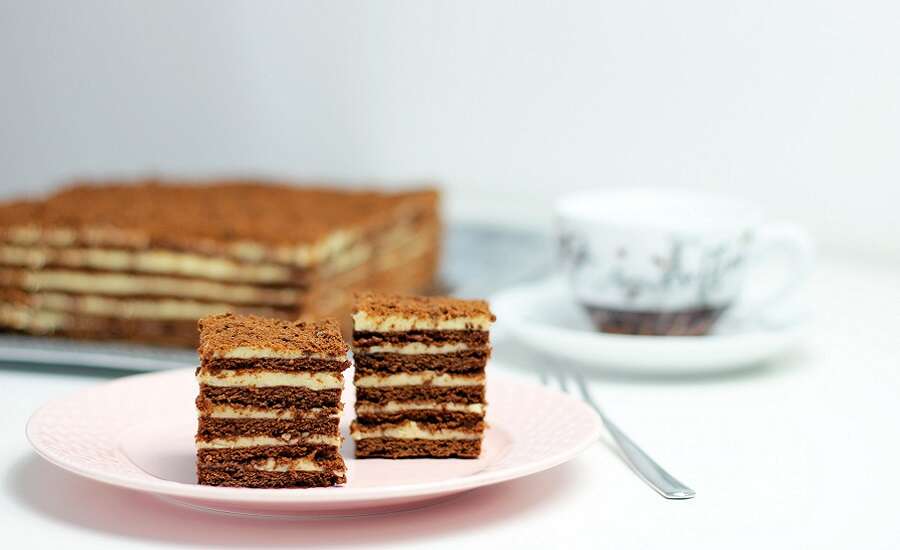Russian New Year’s Recipes
What do Russians Cook on New Year?
- Salads: Slathered in mayonnaise and filled with salty and sour pickles, Russian salads are definitely not guilt free. In fact, they’re about as indulgent as a roast dinner. On New Year, these sumptuously creamy and predominantly beet-red salads take up almost all of the table-space.
- Caviar: Even poor Russians have caviar on their tables at New Year. Mostly it’s just served on top of a small, buttered slice of baguette, so as to let the fishy flavours shine out.
- Meat jelly: This is the only Russian dish that really deserves it’s reputation. Apparently even Russians aren’t mad about its flavour, and only cook it for it’s supposed health-benefits.
In the Soviet times there wasn’t much cause to celebrate. In fact, to be precise, there were only two proper holidays in the year: May day and New Year’s Eve. Though the economic situation has since altered considerably, traditions are still fixed in the Soviet era. Easter and Christmas are still solely seen as sacred holidays for pious worshippers and holidays like Halloween are practically illegal. There is an upside to the sparsity of holidays: when the Russians finally celebrate, my oh my do they celebrate! New Year’s in Russia is simply legendary. And here’s the secret: though “Selyodka pod shuboi” (aka fish under fur coat) might sound scary, the components of what make Russian New Year’s Eve great are surprisingly simple. Here’s our ultimate guide to cooking, drinking and singing your way to the new year like a Russian!
Olivier Salad
There really isn’t a food more synonymous with New Year than this sinfully rich salad. But the weird thing is that it isn’t actually salad. It’s more like a roast dinner chopped into minuscule pieces and then mixed all together. Inside you’ll find potatoes, carrots, peas, ham, pickles, eggs and a whole jar of mayo (literally) – you can also add small bits of apple to give it a sweet and sour bite! Russians love this salad so much that they serve it straight from a “vedro” (bucket).
10 portions
Ingredients:
7 medium, boiled potatoes
5 boiled carrots
6 pickled cucumbers
1 can of green peas
6 boiled eggs (replace with tofu for plant-based version)
300 g of preferred cured or boiled meat (replace with vegan ham slices for plant-based version)
100 g sour cream
200 g mayonnaise
Method:
Finely chop all the boiled vegetables, eggs and meat into small cubes. Pour into a large bowl (or bucket!) and mix in all the other ingredients. Add salt to taste.
Pro tip: Just like a killer curry, olivier tastes better after it has stood in the fridge for a day.
Vinaigrette
Photo by misskursovie2013 on Pixabay
Bright red with specks of green, this salad is as visually arresting as it is sensually. It’s a lot lighter on the calories than olivier and it’s definitely got a kick to it! Just like peanut butter & jelly, the combination of sauerkraut, pickled cucumbers, dill and beetroot can seem a bit funky for some, but for most it tickles all the right taste buds.
4 portions
Ingredients:
2 boiled beetroot
1 boiled carrot
2 pickled cucumbers
3 boiled potatoes
1 onion
3 tbsp canned peas
100g sauerkraut
2-3 tbsp sunflower oil
Method:
Finely chop all the boiled vegetables, onions and pickles into small cubes. Place in a bowl and mix in the sauerkraut, peas and oil. Add salt to taste.
Pro tip: Use unrefined sunflower oil to achieve a really authentic vinaigrette and garnish with finely chopped dill.
Caviar canapés
Photo by marinamarusya13 on Pixabay
Caviar isn’t a luxury in Russia; it’s a staple. In the Soviet times people used to eat it straight from the jar by the spoonful. Now the falling sturgeon populations have sent the prices of back caviar surging, so Russians, for the most part, now use red caviar. Regardless of the color, they still eat an awful lot of it. On New Year they generally go for something more refined than simply scooping out the jar, usually they smother it onto “butterbrots” (buttered white bread) or sometimes they may pile it up onto blinis.
2 portions
Ingredients:
60 grams of red caviar (approx. 4 tsp)
4 slices of a baguette
40 grams of butter
1 tbsp of finely chopped dill
Method:
Butter the bread generously. Then spoon the caviar onto the top and garnish with dill.
Selyodka pod shuboi
Photo on YandexDzen
The mere mention of this dish, translated as “herring under fur coat” is enough to spook non-Russians but, though it may sound wacky and challenging to make, it is neither. As long as you don’t mind a bit of beetroot and a lot of mayonnaise it can be rather delectable and it really is a stroll in the park to make; just grate all the ingredients and stack them into layers. This is definitely a showstopper. The vibrantly colored layers make it look almost like a cake— a fishy, beetroot cake!
4 portions
Ingredients:
1 small herring (or 3 sheets of nori for a plant-based version)
1 white (preferably sweet) onion
1-2 boiled and peeled potatoes
1 boiled and peeled carrot
3 boiled eggs (or tofu for a plant-based version)
1 boiled and peeled beetroot
3-5 tbsp of mayonaise
Method:
Grate all the boiled vegetables and eggs on a large grater. Make sure to keep all the ingredients separate in small bowls as they will be used to form layers in the salad. Peel and finely chop the onion. Then clean and fillet the fish and place at the bottom of a spring form pan (alternatively place the nori sheets or fish at the bottom with a dollop of mayonnaise between the sheets). Then add the onions as the next layer. Next add the grated potatoes with a dollop of mayonnaise, pressing firmly down so that distinct, compact layers are formed. Then add the carrots, after which comes the egg and finally the beetroot which should be smothered with as much mayonnaise as you can possibly allow yourself to eat! Leave to set in the fridge for a few hours, then remove the salad from the spring form pan. Cut into generous slices to serve.
Pro tip: Don’t grate the vegetables too finely; you want there to be some texture to the layers. Garnish with a handful of finely chopped dill to make it über Russian.
Kholodets
Photo by Andy Walther on Pixabay
It’s rather difficult to describe this dish in appetizing terms, but for some reason Russians eat an awful lot of it. Perhaps the obsession with this dish that is basically a russified-version of aspic can be explained by the old grandma’s tale that boiled pigs feet are somehow healthy. Setting the reasons (and smell!) aside, it is a traditional New Year’s food and this translucent jelly with shreds of meat definitely looks interesting, if not appealing.
5 portions
Ingredients:
1 pork knuckle
2 pork shanks
1 whole chicken
2 carrots
2 onions
2 roots of parsley
3 garlic cloves
4 bay leaves
1 tsp. allspice
1 tsp. ground back pepper
Salt to taste
Method:
Rinse the meat in cool water and soak it in a pan of water for 6-8 hours.
Drain the water and cover the meat with clean water.
Then place the pan on medium a medium gas flame. Bring the water to a boil, then lower the gas so the water is kept at a simmer and cook the meat over low heat for 7-8 hours. Do not cover the pan with a lid. Skim the foam and grease off the surface with a spoon.
After 2-3 hours of cooking, add the carrots, parsley root, onions and garlic to the pan.
One hour before the end of cooking, add all the spices to the pan.
Once the meat is ready, remove it from the pan and transfer it to a plate. Season the broth with salt. The vegetables can be removed and used in a homemade soup.
Shred the meat into thin pieces and put it in a mold. Pour the broth over the meat and let it cool at room temperature. Once cooled, place in the refrigerator till set.
Pro tip: Garnish with parsley and freshly ground black pepper.
What about dessert?
For the Soviets, even a simple banana was a rare treat and something as sumptuous as cakes were even rarer. Nowadays Russians will probably round the evening off with something sweet, but there are no specific traditions. However, if you would like to try to bake a Russian dessert, Medovik (honey cake) is absolutely divine.
Tangerines and Champagne
Photo by anncapictures on Pixabay
Naturally Russians couldn’t celebrate New Year’s without their national drink, vodka. Throughout the night, long and quite serious toasts to the year gone by will be made with it, but for the main toast at 12:00, vodka isn’t grand enough and the only thing suitable is champagne— or rather, sovetskaya champagne. Sovetskaya champagne (soviet champagne) is, as the name suggests, a mass-produced sparkling wine devoid of any sort of subtly of flavor. Though one can buy dry soviet champagne, the many Russians to this day enjoy the sickly sweet version. For once, we’d say that when it comes to the booze on New Year’s the Russkies have got it wrong!
Coming to Russia for the New Year? Learn about New Year celebrations in Moscow and in St. Petersburg.
